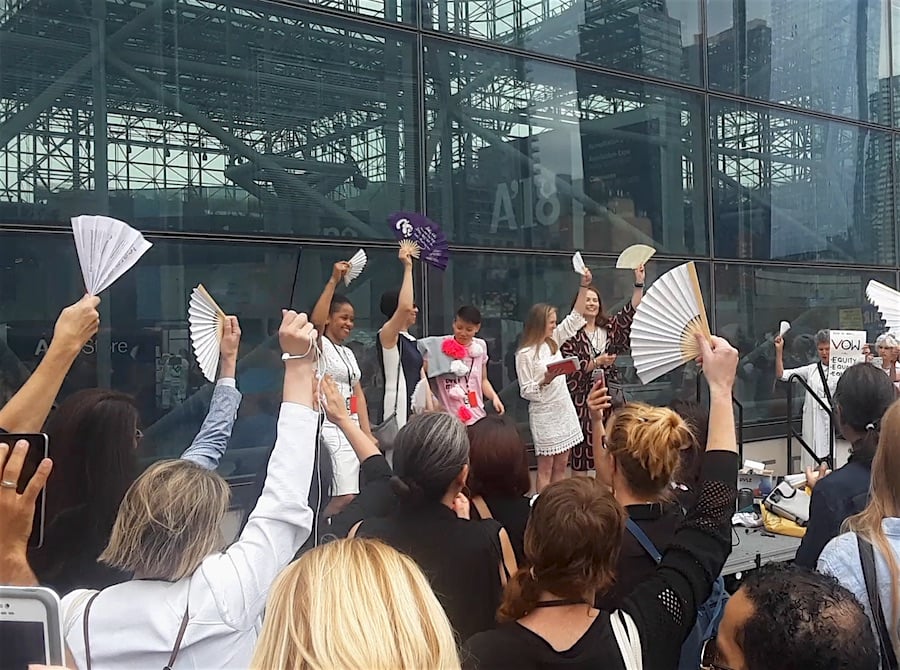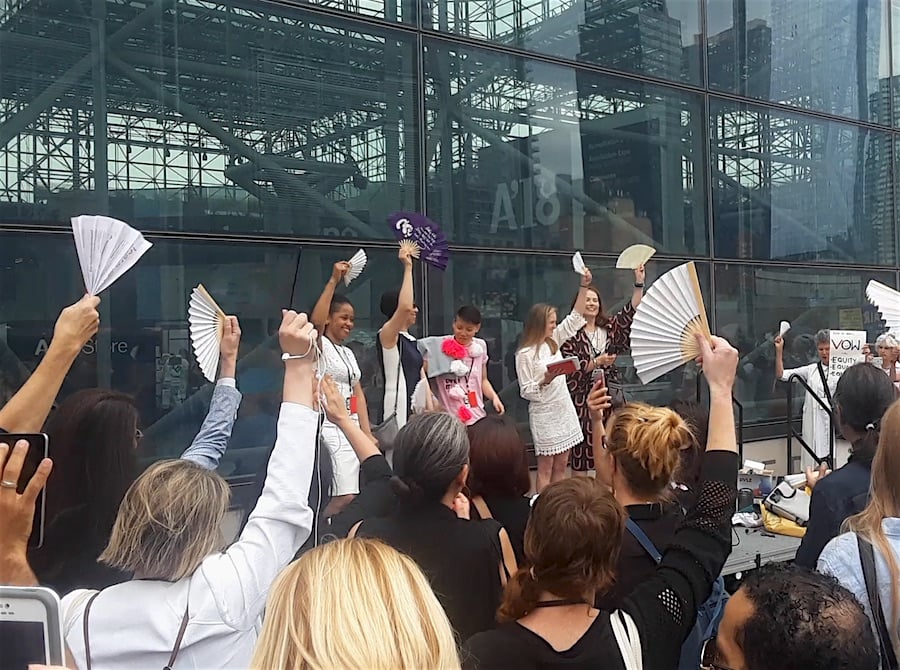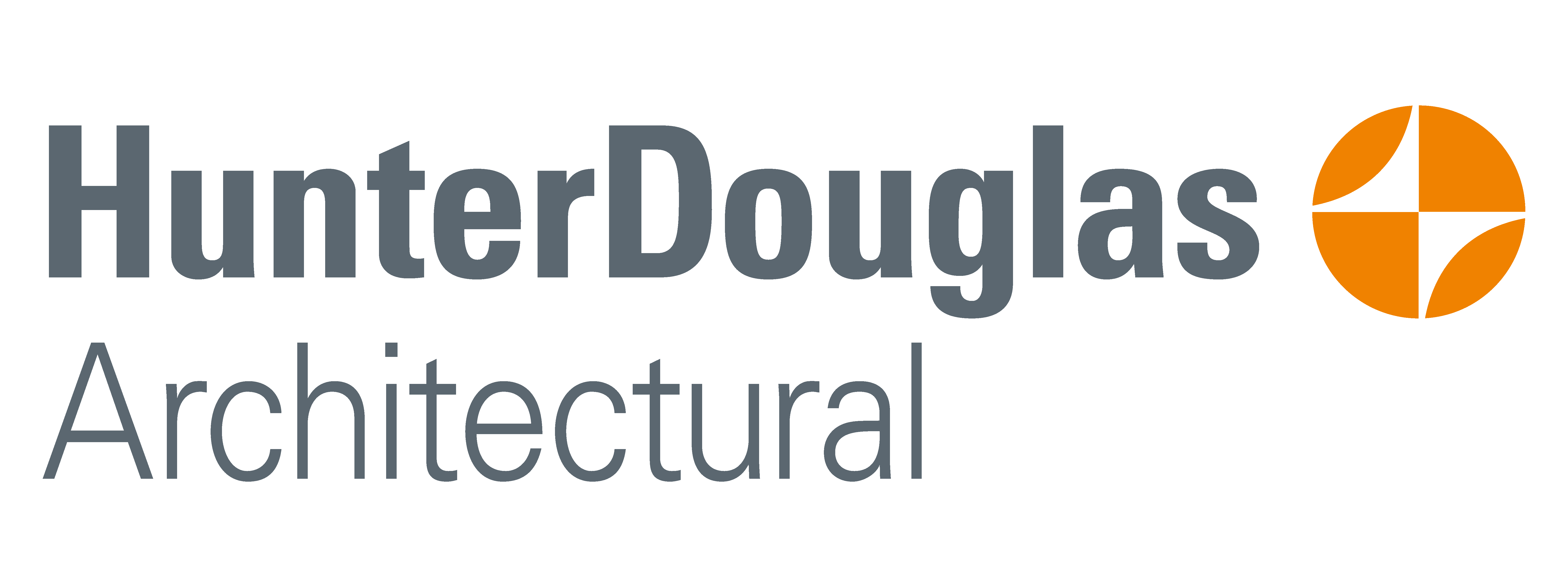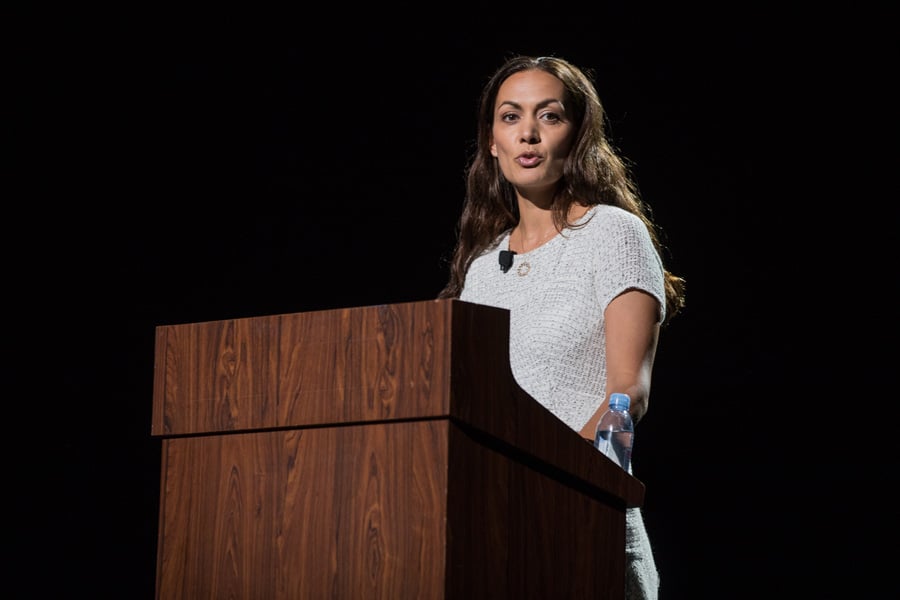
June 26, 2018
In the Wake of #MeToo, Equity Is Put Front and Center at AIA Conference
This year’s annual AIA summit had a notably more diverse and inclusive program, but still alluded to the significant challenges ahead.

At 12:30 p.m. last Friday afternoon, a crowd of about 150 demonstrators, primarily women, clustered near the entrance of New York’s Javits Center during the AIA Conference on Architecture. The protest’s organizers, which included Caroline James, Beverly Willis, and Rosa Sheng—all influential figures in architecture’s women’s movement—bore megaphones and read from a manifesto demanding equity in a profession dominated by men.
In homage to a similar protest staged at the Venice Architecture Biennale last month, participants calling themselves the “voices of plurality” waved red and white paper fans and chanted, “This is what a feminist looks like.” Though their voices were drowned out by a line of idling busses across the street and the din emanating from the surrounding Hudson Yards, their message was clear: the architectural profession is still in desperate need of change.
Friday’s protest capped off the second day of the AIA’s programming—the 161st such gathering in the Institute’s history—and served as an amplified version of the conversations happening both inside and outside the Javits’s crystalline confines.
For years, the profession has been grappling with an equity and diversity problem, as reflected in a series of weary, oft-cited statistics: only some 20 percent of licensed architects are women; less than 2 percent of licensed architects are African American; less than three-tenths of a percent are African American women. And with the added pressure to address these issues in a #MeToo climate, the conference seemed the prime opportunity to take action.
In many ways, it did.
The conference’s hundreds of sessions (attendance earns architects one “learning unit”— credits that are essential for maintaining architectural licensure) had a markedly more progressive bent, including—in addition to lectures on cities, public health, and resiliency—seminars on tackling the gender pay gap, housing refugees, fostering diversity, and designing equitable public spaces.
A particularly rousing panel (though occupying a bleary-eyed 7:30 a.m. time slot) hosted by EquityxDesign’s Rosa Sheng and featuring Chicago architect Katherine Darnstadt, “Hip Hop Architect” Michael Ford, and Open Architecture Collaborative director Garrett Jacobs, was unflinching in its assessment of the profession. “We spend a lot of money [on diversity initiatives]…and we can’t f— up more than we already have,” said Ford, calling on the AIA to fund small grassroots programs like his that bring architecture to kids in the inner city. One attendee, a young African American architect, thanked the panelists for helping her not “feel as lonely.”

This year, the conference’s roster of keynote speakers and honorees notably reflected women and people of color, including David Adjaye, BIG’s Sheela Søgaard, and author and critic Sarah Williams Goldhagen. (Just two years ago, Kevin Spacey was set to headline the conference; he cancelled due to a scheduling conflict.) Tamara Eagle Bull, the first Native American woman to become a licensed architect received the prestigious Whitney M. Young Jr. Award, so-named in honor of the civil rights activist.
Arguably the most important, actionable outcome of the conference was the AIA’s passing of Resolution 18-16 last week, an amendment to the Institute’s Code of Ethics and Professional Conduct requiring members to commit to “the equitable treatment of design professionals and staff of diverse backgrounds and identities, and to prohibit abuse and harassment within our professional community.”
These shifting priorities were literally made visible. A “Commitment Wall” beckoned architects to “commit to lead” by fostering safe, inclusive, and harassment-free workplaces. Handwritten sticky notes featured phrases like “promoting dignity” and “treating everyone with respect.”
But when it came to actually making good on those pledges, the optics were less than encouraging. As part of conference programming, the AIA offered two separate panels—led by Dr. Shirley Davis, an organizations and HR specialist—on identifying and preventing harassment in the workplace. Her presentation delved into the definition, psychology, and consequences of harassment and how architects and designers can go about countering it. However, only about 20 architects—the majority of them women—attended each workshop.
Meanwhile, up the street in Hell’s Kitchen, the non-profit architectural advocacy organization the Architectural Lobby, held its own “think-in” conference. Sitting on milk crates grouped around a central discussion table, both speakers and attendees (which included several AIA members) unpacked the power structures and hierarchies inherent to the profession that enable and perpetuate a culture of abuse—from low pay to gender discrimination. “‘Cause,” as one member put it in an invitation to the event, “the AIA ain’t cutting it.”
Marc Morial, the current president of the National Urban League, also put it bluntly. Addressing conference attendees from the lectern of Radio City Music Hall to commemorate a half-century since Young himself addressed the AIA, Morial said, “50 years later, sometimes it feels like 1968 has returned.”
“As I look out today, I say that, yes, there have been some incremental steps,” he continued to thunderous applause, “but the profession still has work to do and a long way to go before it truly represents the great tapestry of America.”
You might also like, “At the AIA Conference, Public Health Emerges as a Powerful Tool for Architects.”
Recent Viewpoints
Viewpoints
Google’s Ivy Ross Makes Sense of Color











